An Investigation of the Output Performances of a Triboelectric Nanogenerator Lubricated with TiO2-Doped Oleic Acid
Abstract
:1. Introduction
2. Materials and Methods
2.1. Materials
2.2. Preparation of the TENGs
2.3. Characterization of Triboelectric and Tribological Behaviors
3. Results
3.1. Effect of Materials of Friction Pairs on the Triboelectrical Performances
3.2. Effect of Load and Sliding Speed on the Triboelectrical Performances of PI Films
3.3. Effect of Lubrication with TiO2-Doped Oleic Acid on the Triboelectrical Performances
4. Discussion
4.1. Microstructures of the Worn Surface
4.2. Composition Analysis of the Wear Surface
4.3. Mechanism of TENG Performance Improvementit
5. Conclusions
- (1)
- Different materials, such as PTFE, PDMS, TPU, etc., demonstrate distinct variations in voltage, current, and charge generation, which are closely associated with their unique surface properties.
- (2)
- The voltage, current, and charge generation of TENGs are significantly influenced by the load and velocity conditions. Higher loads and frequencies exacerbate the wear of PI films, resulting in higher electrical energy release.
- (3)
- The triboelectrical performances of the PI film sliding against a steel ball under 0.1 wt% TiO2-doped oleic acid are significantly improved compared to those under dry conditions, with the growth rates of 35.2%, 103.6, and 85.6%.
- (4)
- The COF of the TENG lubricated with 0.1 wt% TiO2-doped oleic acid dropped from 0.31 to 0.066 compared to that under dry conditions. The EDS analysis revealed a uniform distribution of Ti elements on the surface of wear marks, and the addition of 0.1 wt% TiO2 resulted in deeper and wider wear marks on the PI films. The FTIR spectra indicated changes in the molecular structure of the surface wear marks of the PI films after friction, suggesting that TiO2 nanoparticles enhance the interaction between oleic acid and the PI films during friction.
- (5)
- The enhancement mechanism of TiO2-doped oleic acid in TENGs was also analyzed. TiO2-doped oleic acid significantly improved the tribological behaviors and triboelectrical performances of TENGs. The introduction of oleic acid reduced the amount of segments, which are usually created under dry friction condition. Incorporating the appropriate amount (0.1 wt%) of TiO2 into the oleic acid lubricant can reduce surface damage, but it may result in more nano-furrows. The corresponding contact area increases, thereby increasing the voltage, current, and charge generated by the TENGs.
Supplementary Materials
Author Contributions
Funding
Data Availability Statement
Acknowledgments
Conflicts of Interest
References
- Xia, X.; Liu, Q.; Zhu, Y.Y.; Zi, Y. Recent advances of triboelectric nanogenerator based applications in biomedical systems. EcoMat 2020, 2, e12049. [Google Scholar] [CrossRef]
- Yan, L.X.; Mi, Y.J.; Lu, Y.; Qin, Q.H.; Wang, X.Q.; Meng, J.J.; Liu, F.; Wang, N.; Cao, X. Weaved piezoresistive triboelectric nanogenerator for human motion monitoring and gesture recognition. Nano Energy 2022, 96, 107135. [Google Scholar] [CrossRef]
- Kim, D.Y.; Kim, H.S.; Kong, D.S.; Choi, M.; Kim, H.B.; Lee, J.H.; Murillo, G.; Lee, M.; Kim, S.S.; Jung, J.H. Floating buoy-based triboelectric nanogenerator for an effective vibrational energy harvesting from irregular and random water waves in wild sea. Nano Energy 2018, 45, 247–254. [Google Scholar] [CrossRef]
- Cheng, P.; Liu, Y.N.; Wen, Z.; Shao, H.Y.; Wei, A.M.; Xie, X.K.; Chen, C.; Yang, Y.; Peng, M.; Zhuo, Q.; et al. Atmospheric pressure difference driven triboelectric nanogenerator for efficiently harvesting ocean wave energy. Nano Energy 2018, 54, 156–162. [Google Scholar] [CrossRef]
- Bai, Y.; Xu, L.; He, C.; Zhu, L.P.; Yang, X.D.; Jiang, T.; Nie, J.; Zhong, W.; Wang, Z.L. High-performance triboelectric nanogenerators for self-powered, in-situ and real-time water quality mapping. Nano Energy 2019, 66, 104117. [Google Scholar] [CrossRef]
- Han, J.J.; Liu, Y.; Feng, Y.W.; Jiang, T.; Wang, Z.L. Achieving a large driving force on triboelectric nanogenerator by wave-driven linkage mechanism for harvesting blue energy toward marine environment monitoring. Adv. Energy Mater. 2023, 13, 202203219. [Google Scholar] [CrossRef]
- Zhou, Z.H.; Li, X.S.; Wu, Y.F.; Zhang, H.; Lin, Z.W.; Meng, K.Y.; Lin, Z.; He, Q.; Sun, C.; Yang, J.; et al. Wireless self-powered sensor networks driven by triboelectric nanogenerator for in-situ real time survey of environmental monitoring. Nano Energy 2018, 53, 501–507. [Google Scholar] [CrossRef]
- Wu, Z.Y.; Guo, H.Y.; Ding, W.B.; Wang, Y.C.; Zhang, L.; Wang, Z.L. A hybridized triboelectric-electromagnetic water wave energy harvester based on a magnetic sphere. ACS Nano 2019, 13, 2349–2356. [Google Scholar] [CrossRef]
- Li, X.Y.; Tao, J.; Wang, X.D.; Zhu, J.; Pan, C.F.; Wang, Z.L. Networks of high performance triboelectric nanogenerators based on liquid-solid interface contact electrification for harvesting low-frequency blue energy. Adv. Energy Mater. 2018, 8, 1800705. [Google Scholar] [CrossRef]
- Chen, P.F.; An, J.; Shu, S.; Cheng, R.W.; Nie, J.H.; Jiang, T.; Wang, Z.L. Super-durable, low-wear, and high-performance fur-brush triboelectric nanogenerator for wind and water energy harvesting for smart agriculture. Adv. Energy Mater. 2021, 11, 2003066. [Google Scholar] [CrossRef]
- Chen, B.D.; Tang, W.; He, C.; Deng, C.R.; Yang, L.J.; Zhu, L.P.; Chen, J.; Shao, J.J.; Liu, L.; Wang, Z.L. Water wave energy harvesting and self-powered liquid-surface fluctuation sensing based on bionic-jellyfish triboelectric nanogenerator. Mater. Today 2018, 21, 88. [Google Scholar] [CrossRef]
- Wang, W.L.; Yang, D.F.; Yan, X.R.; Wang, L.C.; Hu, H.; Wang, K. Triboelectric nanogenerators: The beginning of blue dream. Front. Chem. Sci. Eng. 2023, 17, 635–678. [Google Scholar] [CrossRef]
- Liu, X.; Yu, A.F.; Qin, A.M.; Zhai, J.Y. Highly Integrated Triboelectric Nanogenerator for Efficiently Harvesting Raindrop Energy. Adv. Mater. Technol. 2019, 4, 1900608. [Google Scholar] [CrossRef]
- Wang, J.L.; Yu, X.; Zhao, D.; Yu, Y.; Gao, Q.; Cheng, T.H.; Wang, Z.L. Enhancing Output Performance of Triboelectric Nanogenerator via Charge Clamping. Adv. Energy Mater. 2021, 11, 2101356. [Google Scholar] [CrossRef]
- Feng, J.R.; Zhou, H.L.; Cao, Z.; Zhang, E.Y.; Xu, S.X.; Li, W.T.; Yao, H.L.; Wan, L.Y.; Liu, G.L. 0.5 m Triboelectric Nanogenerator for Efficient Blue Energy Harvesting of All-Sea Areas. Adv. Sci. Weinh. 2022, 9, 202204407. [Google Scholar] [CrossRef] [PubMed]
- Chen, X.; Cao, B.; Yang, C.; Zhang, H.N.; Fang, L.; Chen, C.; Wang, Z.X.; He, W.; Wang, P.H. Broadband and Multi-Cylinder-Based Triboelectric Nanogenerators for Mechanical Energy Harvesting with High Space Utilization. Materials 2023, 16, 3034. [Google Scholar] [CrossRef]
- Yuan, Z.; Guo, L. Recent advances in solid–liquid triboelectric nanogenerator technologies, affecting factors, and applications. Sci. Rep. 2024, 14, 10456. [Google Scholar] [CrossRef] [PubMed]
- Lin, S.H.; Chen, X.Y.; Wang, Z.H. Contact Electrification at the Liquid–Solid Interface. Chem. Rev. 2022, 122, 5209–5232. [Google Scholar] [CrossRef] [PubMed]
- Chatterjee, S.; Burman, S.R.; Khan, I.; Saha, S.; Choi, D.; Lee, S.; Lin, Z.H. Recent advancements in solid–liquid triboelectric nanogenerators for energy harvesting and self-powered applications. Nanoscale 2020, 12, 17663–17697. [Google Scholar] [CrossRef]
- Kulandaivel, A.; Potu, S.; Babu, A.; Madathil, N.; Velpula, M.; Rajaboina, R.K.; Khanapuram, U.K. Advances in ferrofluid-based triboelectric nanogenerators: Design, performance, and prospects for energy harvesting applications. Nano Energy 2024, 120, 109110. [Google Scholar] [CrossRef]
- Tan, J.; Sun, S.; Jiang, D.Y.; Xu, M.Y.; Chen, X.Y.; Song, Y.C.; Wang, Z.H. Advances in triboelectric nanogenerator powered electrowetting-on-dielectric devices: Mechanism, structures, and applications. Mater. Today 2022, 58, 201–220. [Google Scholar] [CrossRef]
- Wu, J.; Xi, Y.H.; Shi, Y.J. Toward wear-resistive, highly durable and high performance triboelectric nanogenerator through interface liquid lubrication. Nano Energy 2020, 72, 104659. [Google Scholar] [CrossRef]
- Wang, K.Q.; Li, J.J.; Li, J.F.; Wu, C.Y.; Yi, S.; Liu, Y.F.; Luo, J.B. Hexadecane-containing sandwich structure based triboelectric nanogenerator with remarkable performance enhancement. Nano Energy 2021, 87, 106198. [Google Scholar] [CrossRef]
- Liu, X.; Zhang, J.; Zhang, L.; Feng, Y.; Feng, M.; Luo, N.; Wang, D. Influence of interface liquid lubrication on triboelectrification of point contact friction pair. Tribol. Int. 2022, 165, 107323. [Google Scholar] [CrossRef]
- Qiao, W.Y.; Zhou, L.L.; Zhao, Z.H.; Yang, P.Y.; Liu, D.; Liu, X.R.; Liu, J.Q.; Liu, D.Y.; Wang, Z.L.; Wang, J. MXene lubricated tribovoltaic nanogenerator with high current output and long lifetime. Nano-Micro Lett. 2023, 15, 218. [Google Scholar] [CrossRef]
- Yang, D.L.; Zhang, L.Q.; Luo, N.; Liu, Y.; Sun, W.X.; Peng, J.L.; Feng, M.; Feng, Y.E.; Wang, H.F.; Wang, D.A. Tribological-behaviour-controlled direct-current triboelectric nanogenerator based on the tribovoltaic effect under high contact pressure. Nano Energy 2022, 99, 107370. [Google Scholar] [CrossRef]
- Rajendhran, N.; Palanisamy, S.; Periyasamy, P.; Venkatachalam, R. Enhancing of the tribological characteristics of the lubricant oils using Ni-promoted MoS2 nanosheets as nano-additives. Tribol. Int. 2018, 118, 314–328. [Google Scholar] [CrossRef]
- Yin, X.; Jin, J.; Chen, X.C. Ultra-Wear-Resistant MXenes-Based Composite Coating via In-Situ Formed Nanostructured Tribofilm. ACS Appl. Mater. Interfaces 2019, 11, 32569–32576. [Google Scholar] [CrossRef]
- Del, R.J.; López, E.R.; Fernández, J. Tribological properties of graphene nanoplatelets or boron nitride nanoparticles as additives of a polyalphaolefin base oil. J. Mol. Liq. 2021, 333, 115911. [Google Scholar]
- Guo, Y.F.; Zhang, L.Q.; Du, C.H.; Feng, Y.E.; Yang, D.; Zhang, Z.T.; Feng, M.; Wan, Y.; Wang, D.A. Onion-like carbon as nano-additive for tribological nanogenerators with enhanced output performance and stability. Nano Energy 2022, 104, 107900. [Google Scholar] [CrossRef]
- Guo, L.H.; Zhang, Y.M.; Zhang, G.; Wang, Q.H.; Wang, T.M. MXene-Al2O3 synergize to reduce friction and wear on epoxy-steel contacts lubricated with ultra-low sulfur diesel. Tribol. Intenational 2021, 153, 106588. [Google Scholar] [CrossRef]
- Chen, J.Z.; Zhao, Y.; Wang, R.R.; Wang, P.F. Super-Low Friction Electrification Achieved on Polytetrafluoroethylene Films-Based Triboelectric Nanogenerators Lubricated by Graphene-Doped Silicone Oil. Micromachines 2023, 14, 1776. [Google Scholar] [CrossRef]
- Li, S.Y.; Fan, Y.; Chen, H.Q.; Nie, J.H.; Liang, Y.X.; Tao, X.L.; Zhang, J.; Chen, X.Y.; Fu, E.G.; Wang, Z.L. Manipulating the triboelectric surface charge density of polymers by low-energy helium ion irradiation/implantation. Energy Environ. Sci. 2020, 13, 896–907. [Google Scholar] [CrossRef]
- Takada, T.; Kikuchi, H.; Miyake, H.; Tanaka, Y.; Yoshida, M.; Hayase, Y. Determination of Charge-trapping Sites in Saturated and Aromatic Polymers by Quantum Chemical Calculation. IEEE Trans. Dielectr. Electr. Insul. 2015, 22, 1240–1249. [Google Scholar] [CrossRef]
- Albina, A.; Taberna, P.L.; Cambronne, J.P.; Simon, P.; Flahaut, E.; Lebey, T. Impact of the surface roughness on the electrical capacitance. Microelectron. J. 2006, 37, 752–758. [Google Scholar] [CrossRef]
- Macuk, A.L. Electrical Characteristics and Surface Properties of Polycrystalline Silicon Exposed to Morphological Alteration with Applications in Micro- and Nanotechnology. Master’s Thesis, Bradley University, Peoria, IL, USA, 2014. [Google Scholar]
- Lee, B.Y.; Kim, D.H.; Park, J.; Park, K.I.; Lee, K.J.; Jeong, C.K. Modulation of surface physics and chemistry in triboelectric energy harvesting technologies. Sci. Technol. Adv. Mater. 2019, 20, 758–773. [Google Scholar] [CrossRef]
- Yu, J.B.; Hou, X.J.; He, J.; Cui, M.; Wang, C.; Geng, W.P.; Mu, J.L.; Han, B.; Chou, X.J. Ultra-flexible and high-sensitive triboelectric nanogenerator as electronic skin for self-powered human physiological signal monitoring. Nano Energy 2020, 69, 104437. [Google Scholar] [CrossRef]
- Kim, D.; Jeon, S.B.; Kim, J.Y.; Seol, M.L.; Kim, S.O.; Choi, Y.K. High-performance nanopattern triboelectric generator by block copolymer lithography. Nano Energy 2015, 12, 331–338. [Google Scholar] [CrossRef]
- Cheng, G.G.; Jiang, S.Y.; Li, K.; Zhang, Z.Q.; Wang, Y.; Yuan, N.Y.; Ding, J.N.; Zhang, W. Effect of argon plasma treatment on the output performance of triboelectric nanogenerator. Appl. Surf. Sci. 2017, 412, 350–356. [Google Scholar] [CrossRef]
- Zhang, C.; Tang, W.; Han, C.B.; Fan, F.R.; Wang, Z.L. Theoretical Comparison, Equivalent Transformation, and Conjunction Operations of Electromagnetic Induction Generator and Triboelectric Nanogenerator for Harvesting Mechanical Energy. Adv. Mater. 2014, 26, 3580–3591. [Google Scholar] [CrossRef]
- Bian, L.J.; Song, N.N.; Yu, L.G.; Zhang, Y.J.; Zhang, P.Y.; Zhang, S.M. Susceptibility of Poly-Alpha Olefin and Diisooctyl Sebacate Base Oils With Different Polarities to Oleic Acid Surface-Capped Ultra-Small Cerium Oxide Nanoparticle. Lubr. Sci. 2024, 1–11. [Google Scholar] [CrossRef]
- Raina, A.; Arland, A. Effect of nanodiamond on friction and wear behavior of metal dichalcogenides in synthetic oil. Appl. Nanosci. 2018, 8, 581–591. [Google Scholar] [CrossRef]
- Ochoa, I.; Hatzikiriakos, S.G. Paste extrusion of polytetrafluoroethylene (PTFE): Surface tension and viscosity effects. Powder Technol. 2005, 153, 108–118. [Google Scholar] [CrossRef]
- Yin, X.; Mu, L.; Jia, Z.; Pang, H.; Chai, C.; Liu, H.; Liang, C.; Zhang, B.; Liu, D. Nanostructure of superlubricating tribofilm based on friction-induced a-C:H films under various working conditions: A review of solid lubrication. Lubricants 2024, 12, 40. [Google Scholar] [CrossRef]
- Choi, J.; Morishita, H.; Kato, T. Frictional properties of bilayered mixed lubricant films on an amorphous carbon surface: Effect of alkyl chain length and SAM/PFPE portion. Appl. Surf. Sci. 2004, 228, 191–200. [Google Scholar] [CrossRef]
- Tsybanev, G.V.; Belas, O.N. A study of the influence of a lubricant composition on fatigue and wear processes jointly or severally occurring in steel 45. Strength Mater. 2009, 41, 377–386. [Google Scholar] [CrossRef]
- Yuan, C.Q.; Peng, Z.; Zhou, X.C.; Yan, X.P. Effects of temperature on sliding wear process under contaminated lubricant test conditions. Wear 2004, 257, 812–822. [Google Scholar] [CrossRef]
- Wu, C.; Li, S.S.; Ni, J.; Yao, L.D.; Xia, Q. Effect of structure of ZnO and SiO2 core-shell composite nanoparticles as lubricant additive on tribological properties of greases. Appl. Surf. Sci. 2024, 657, 159745. [Google Scholar] [CrossRef]
- Gao, M.; Li, H.Y.; Ma, L.R.; Gao, Y.; Ma, L.R.; Luo, J.B. Molecular behaviors in thin film lubrication—Part two: Direct observation of the molecular orientation near the solid surface. Friction 2019, 7, 479–488. [Google Scholar] [CrossRef]
- Li, Y.Z.; Li, S.W.; Bai, P.P.; Jia, W.P.; Xu, Q.; Meng, Y.G.; Ma, L.W.; Tian, Y. Surface wettability effect on aqueous lubrication: Van der Waals and hydration force competition induced adhesive friction. J. Colloid Interface Sci. 2021, 599, 667–675. [Google Scholar] [CrossRef]
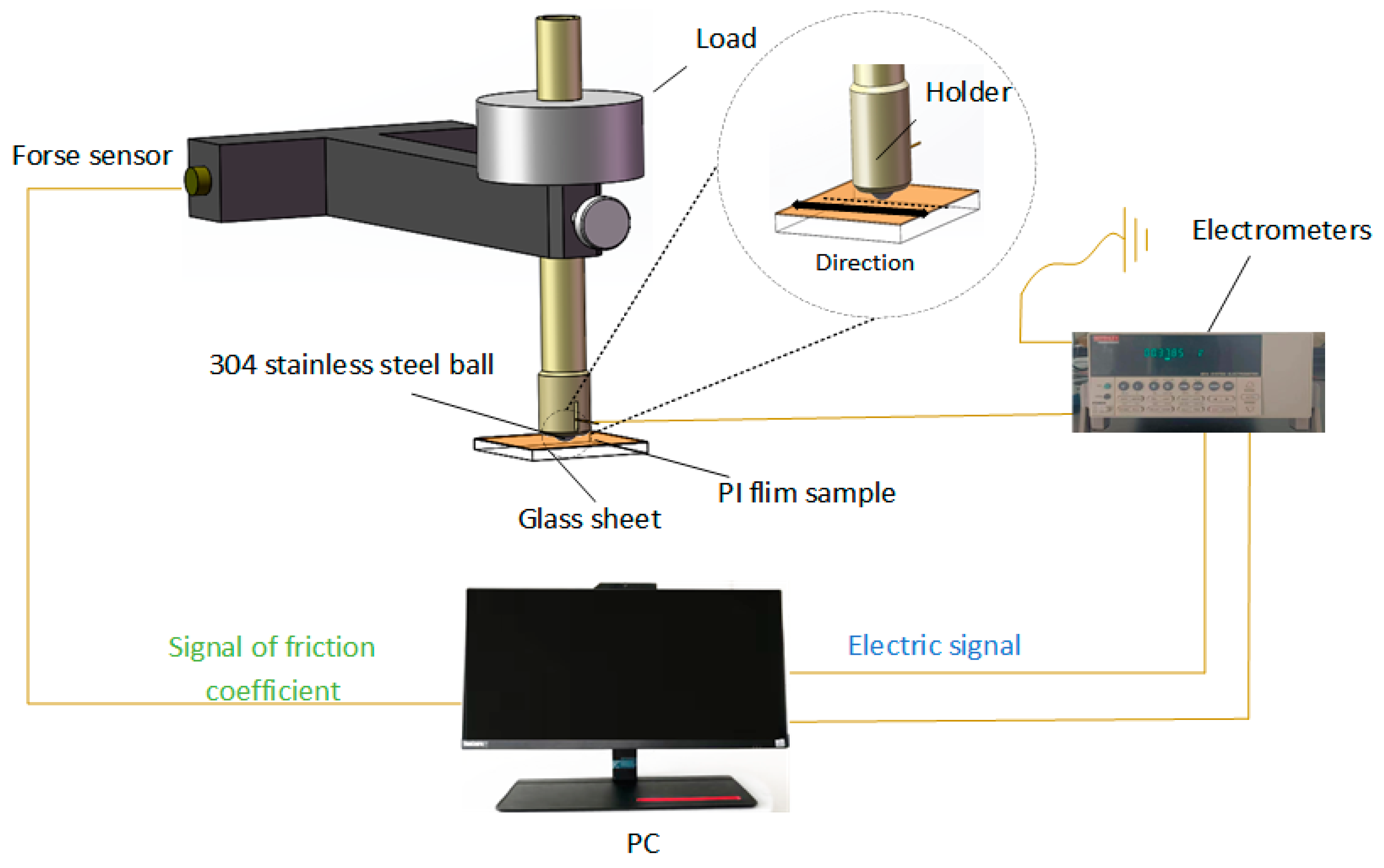

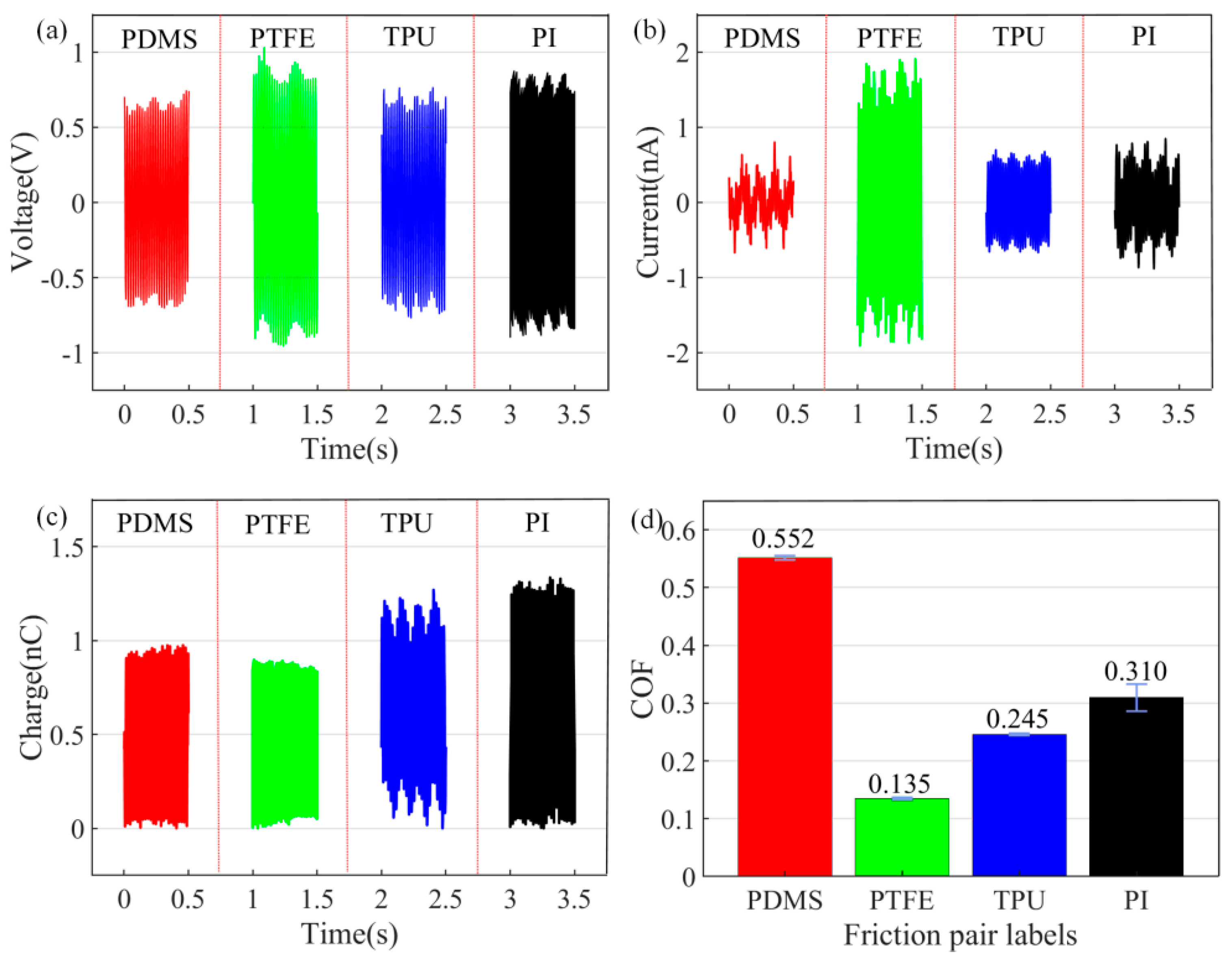


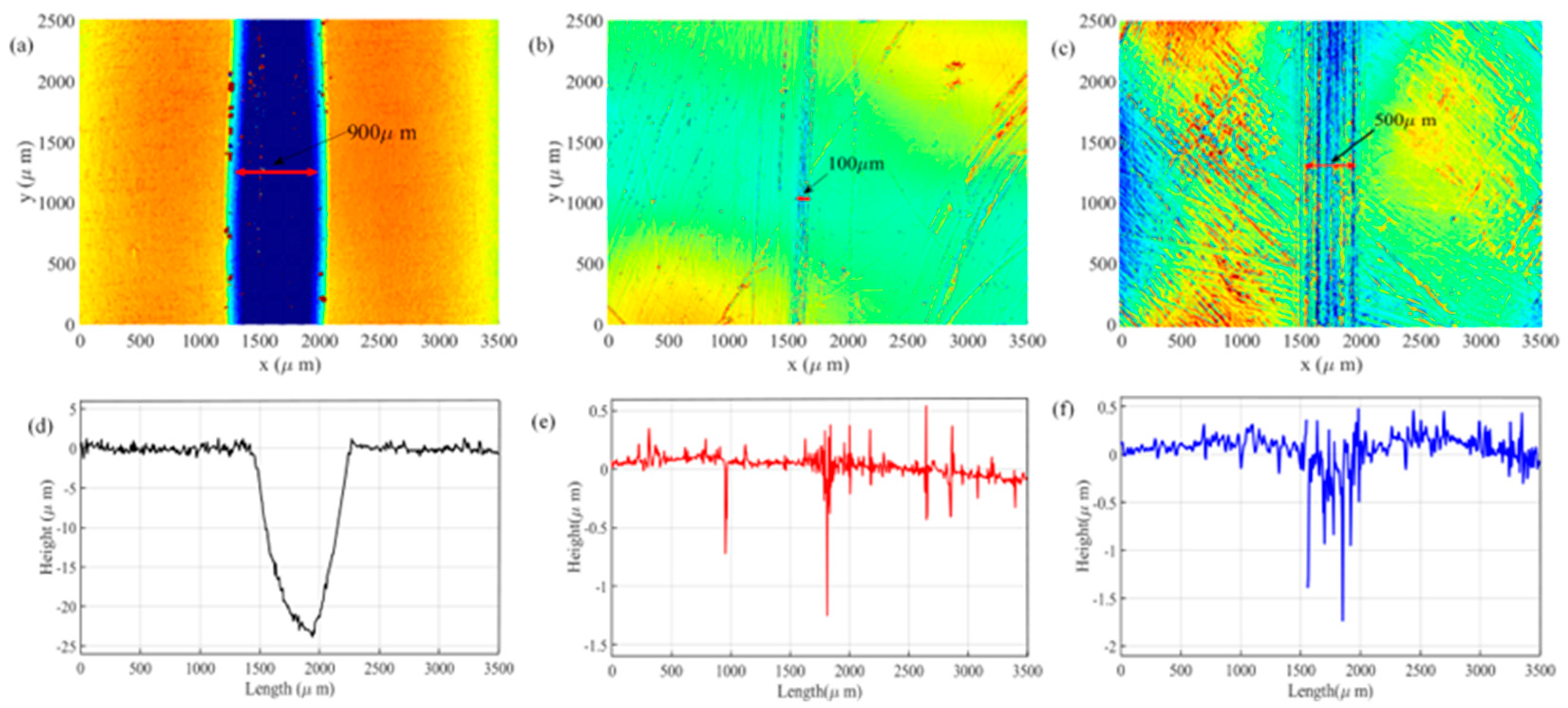

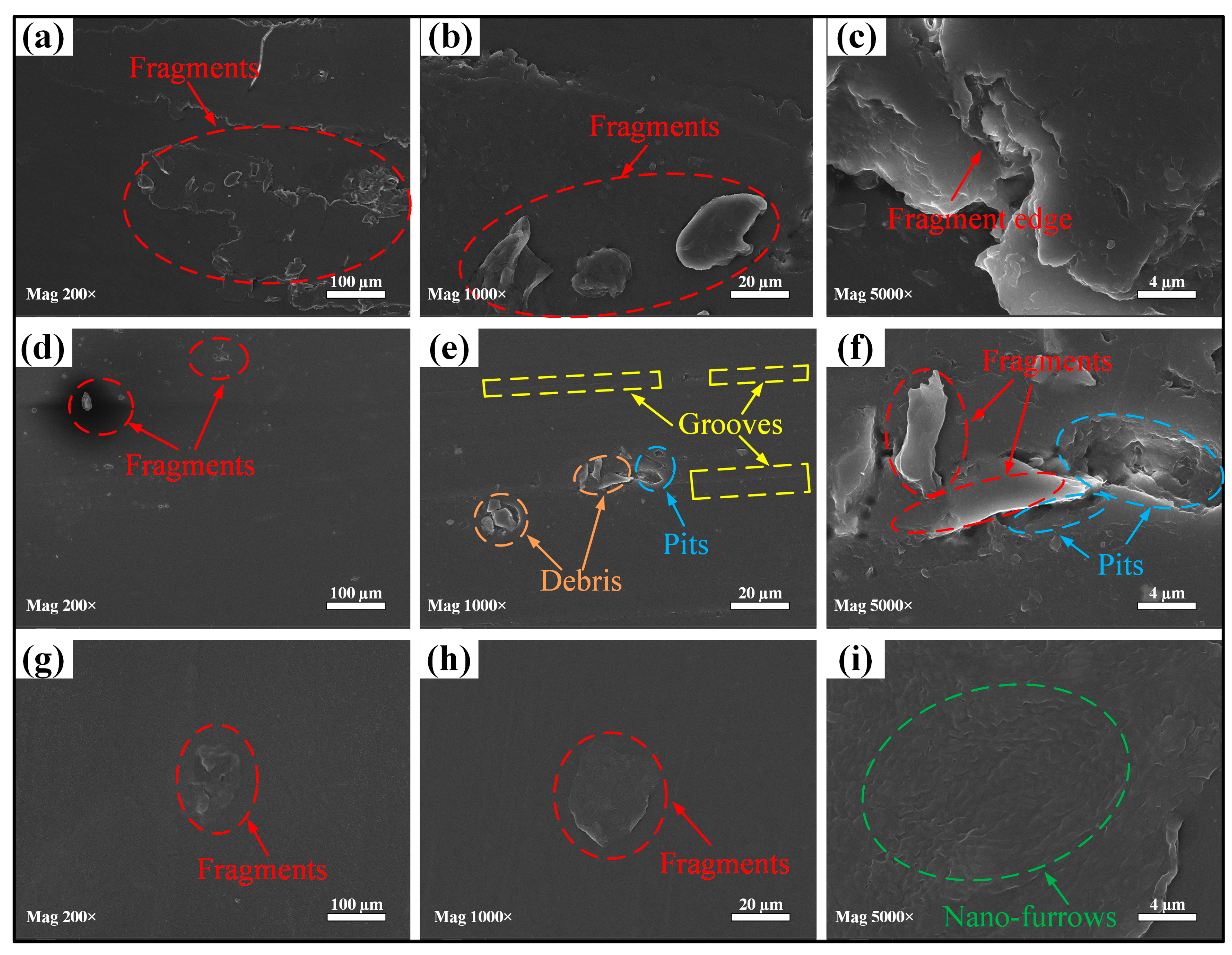
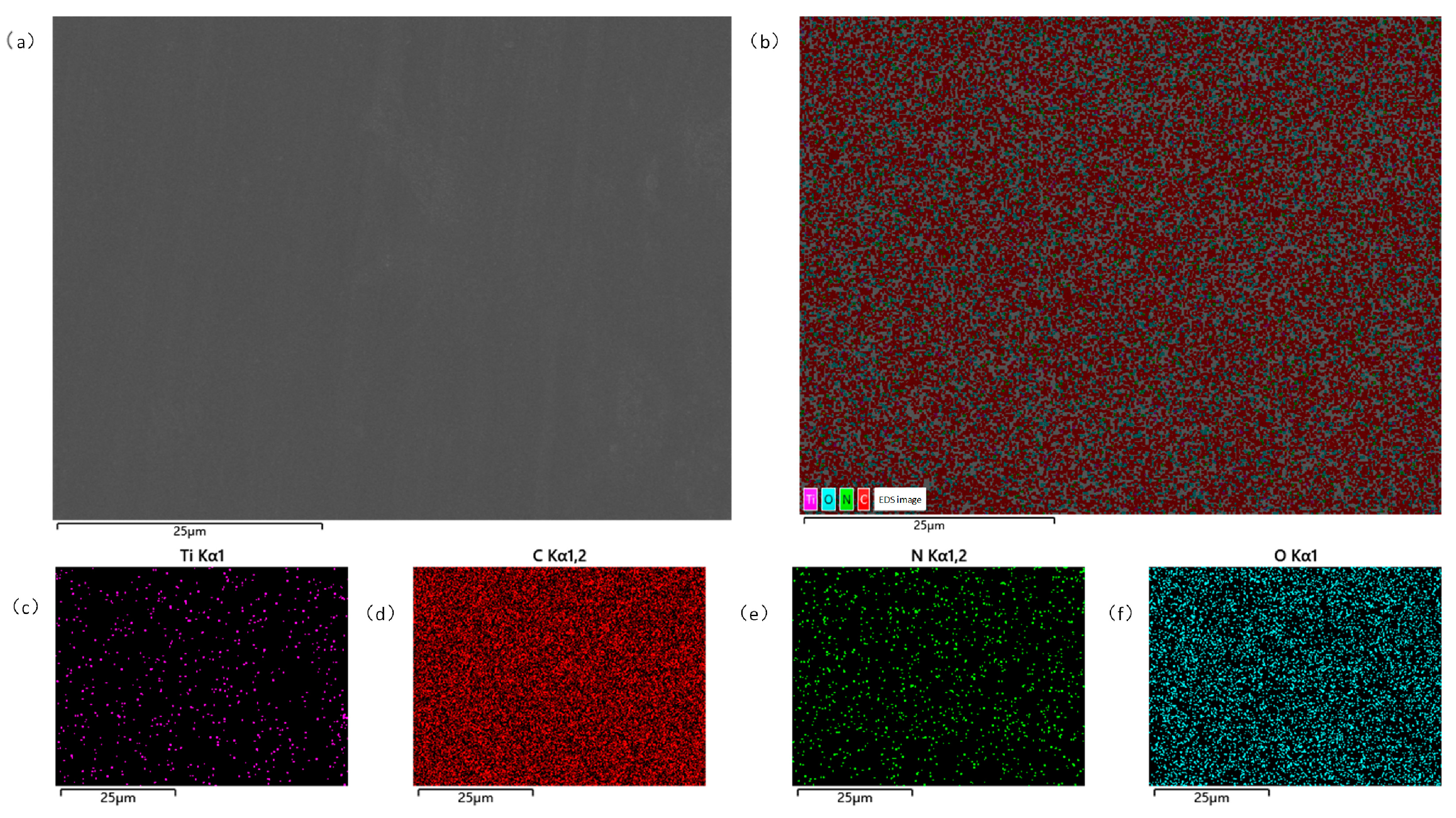
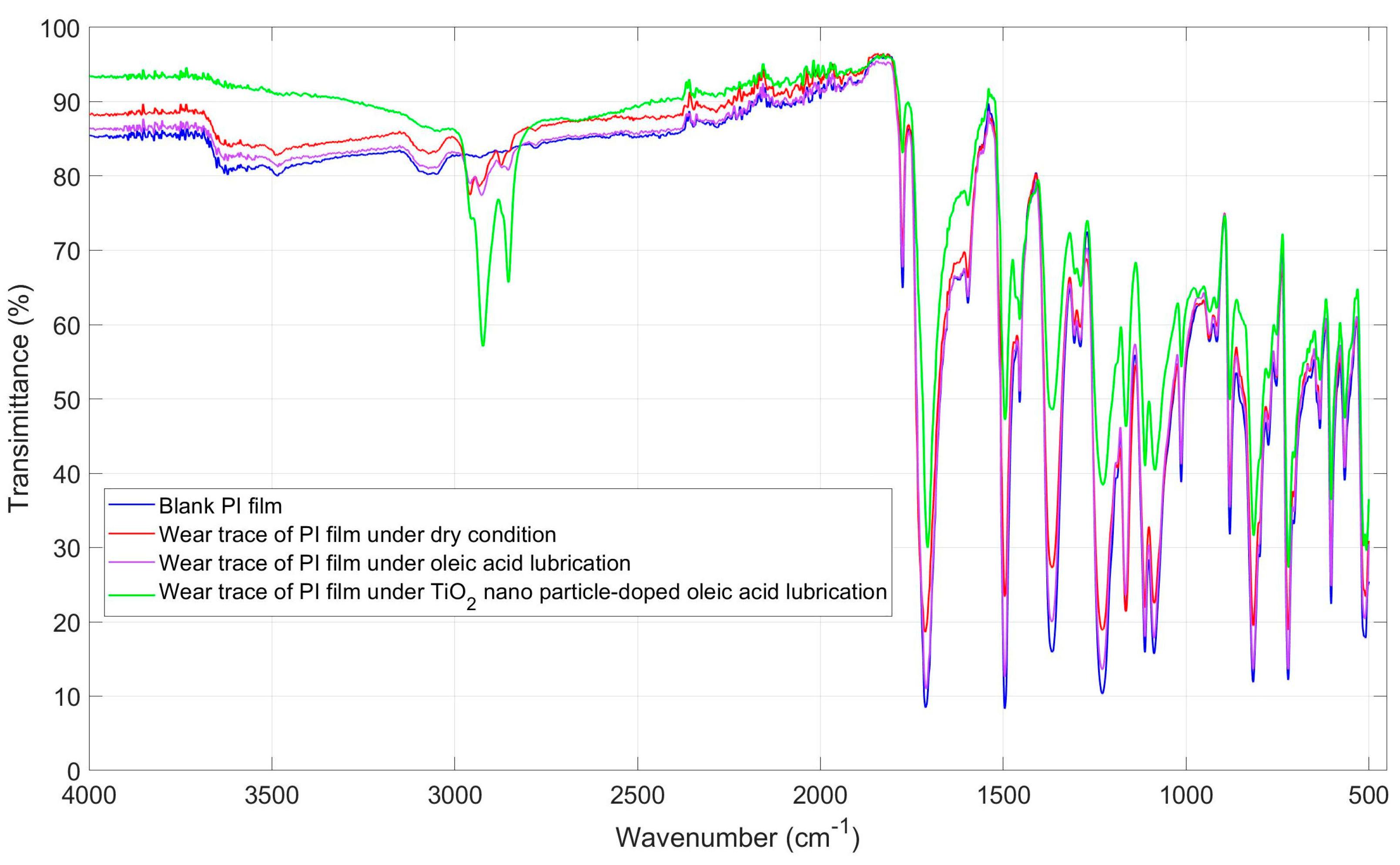
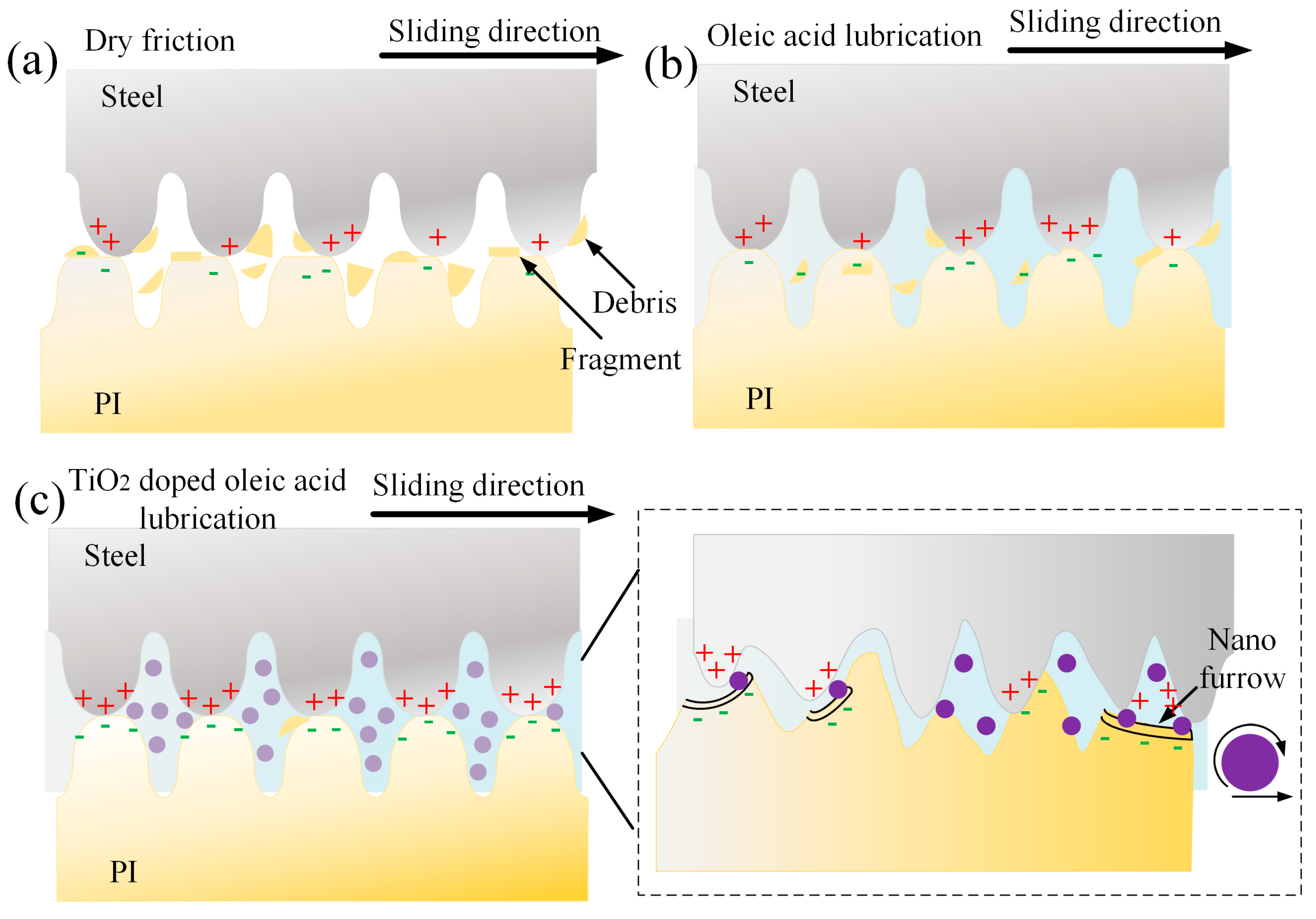
| Designation | Lubrication Condition |
|---|---|
| Dry friction | No lubrication |
| 0.00 wt% | Pure oleic acid |
| 0.01 wt% | Oleic acid Gew. 0.01 wt% TiO2 |
| 0.05 wt% | Oleic acid Gew. 0.05 wt% TiO2 |
| 0.1 wt% | Oleic acid Gew. 0.1 wt% TiO2 |
| 0.5 wt% | Oleic acid Gew. 0.5 wt% TiO2 |
| 1 wt% | Oleic acid Gew. 1 wt% TiO2 |
| 2 wt% | Oleic acid Gew. 2 wt% TiO2 |
Disclaimer/Publisher’s Note: The statements, opinions and data contained in all publications are solely those of the individual author(s) and contributor(s) and not of MDPI and/or the editor(s). MDPI and/or the editor(s) disclaim responsibility for any injury to people or property resulting from any ideas, methods, instructions or products referred to in the content. |
© 2024 by the authors. Licensee MDPI, Basel, Switzerland. This article is an open access article distributed under the terms and conditions of the Creative Commons Attribution (CC BY) license (https://creativecommons.org/licenses/by/4.0/).
Share and Cite
Shao, J.; Yu, G.; He, Y.; Li, J.; Hou, M.; Wang, X.; Zhang, P.; Wang, X. An Investigation of the Output Performances of a Triboelectric Nanogenerator Lubricated with TiO2-Doped Oleic Acid. Lubricants 2024, 12, 269. https://doi.org/10.3390/lubricants12080269
Shao J, Yu G, He Y, Li J, Hou M, Wang X, Zhang P, Wang X. An Investigation of the Output Performances of a Triboelectric Nanogenerator Lubricated with TiO2-Doped Oleic Acid. Lubricants. 2024; 12(8):269. https://doi.org/10.3390/lubricants12080269
Chicago/Turabian StyleShao, Jiaqi, Guoyan Yu, Yixing He, Jun Li, Mingxing Hou, Xianmin Wang, Ping Zhang, and Xianzhang Wang. 2024. "An Investigation of the Output Performances of a Triboelectric Nanogenerator Lubricated with TiO2-Doped Oleic Acid" Lubricants 12, no. 8: 269. https://doi.org/10.3390/lubricants12080269





